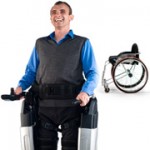Archive for 2010
Development of a Modular‐type Knee‐assistive Wearable System
- Тип контента: Научная статья
- Номер документа: 7269
- Название документа: Development of a Modular‐type Knee‐assistive Wearable System
- Номер (DOI, IBSN, Патент): 10.5143/JESK.2010.29.3.357
- Изобретатель/автор: Seung Nam Yu, Jung Soo Han, Chang Soo Han
- Правопреемник/учебное заведение: Department of Mechanical Engineering, Hanyang University, Ansan, Department of Mechanical System Engineering, Hansung University, Seoul
- Дата публикации документа: 2010-06-19
- Страна опубликовавшая документ: Корея
- Язык документа: Английский
- Наименование изделия: Не заполнено
- Источник: Journal of the Ergonomics Society of Korea Vol. 29, No. 3 p
- Вложения: Да
- Аналитик: Глаголева Елена
 This study proposes a lower-limb exoskeleton system that is controlled by a wearer’s muscle activity. This system is designed by following procedure. First, analyze the muscle activation patterns of human leg while walking. Second, select the adequate actuator to support the human walking based on calculation of required force of knee joint for step walking. Third, unit type knee and ankle orthotics are integrated with selected actuator. Finally, using this knee-assistive system (KAS) and developed muscle stiffness sensors (MSS), the muscle activity pattern of the subject is analyzed while he is walking on the stair. This study proposes an operating algorithm of KAS based on command signal of MSS which is generated by motion intent of human. A healthy and normal subject walked while wearing the developed powered-knee exoskeleton on his/her knees, and measured effectively assisted plantar flexor strength of the subject’s knees and those neighboring muscles. Finally, capabilities and feasibility of the KAS are evaluated by testing the adapted motor pattern and the EMG signal variance while walking with exoskeleton. These results shows that developed exoskeleton which controlled by muscle activity could help human’s walking acceptably.
This study proposes a lower-limb exoskeleton system that is controlled by a wearer’s muscle activity. This system is designed by following procedure. First, analyze the muscle activation patterns of human leg while walking. Second, select the adequate actuator to support the human walking based on calculation of required force of knee joint for step walking. Third, unit type knee and ankle orthotics are integrated with selected actuator. Finally, using this knee-assistive system (KAS) and developed muscle stiffness sensors (MSS), the muscle activity pattern of the subject is analyzed while he is walking on the stair. This study proposes an operating algorithm of KAS based on command signal of MSS which is generated by motion intent of human. A healthy and normal subject walked while wearing the developed powered-knee exoskeleton on his/her knees, and measured effectively assisted plantar flexor strength of the subject’s knees and those neighboring muscles. Finally, capabilities and feasibility of the KAS are evaluated by testing the adapted motor pattern and the EMG signal variance while walking with exoskeleton. These results shows that developed exoskeleton which controlled by muscle activity could help human’s walking acceptably.
Категория: Научные статьи | Нет комментариев »
Impedance controlled anthropomorphic exoskeleton model
- Тип контента: Научная статья
- Номер документа: 7655
- Название документа: Impedance controlled anthropomorphic exoskeleton model
- Номер (DOI, IBSN, Патент): Не заполнено
- Изобретатель/автор: Chiel Lintzen
- Правопреемник/учебное заведение: Ecole Polytechnique Federale de Lausanne
- Дата публикации документа: 2010-06-17
- Страна опубликовавшая документ: Франция
- Язык документа: Английский
- Наименование изделия: Не заполнено
- Источник: Не заполнено
- Вложения: Да
- Аналитик: Глаголева Елена
 In this internship report the development of an impedance control method for an anthropomorphic lower extremity exoskeleton is described. This exoskeleton can be used to restore the gait of paralyzed people. Webots simulations are used to test the control method. Therefore a realis-tic model of both the human as the exoskeleton has to be made. The lower extremities of the human model have 6 DOF all in the sagital plane. The human model has only passive elements simulating that the human is fully paralyzed. The actuation is done by the exoskeleton. The human model is compared to a Matlab model of the TU Delft. The joint angle trajectories of both models are approximately the same. The exoske-leton model is anthropomorphic and is assumed to be rigidly at-tached to the user. The actuation is done directly at the joints, so that all sup-plied power is converted into joint rotation. The parameters of the impedance control, stiness, damping and reference trajectory, are phase dependent. They are determined using particle swarm optimization. The optimizations are able to find a gait pattern of the human model wearing the exoskeleton. This gait pattern is compared to the gait of a healthy subject, tracked by the University of Twente. The joint angles of the simulated gait have large similarities with the tracked angles. The developed model can be used to develop and test more complex control methods. By using a monotone fitness function and an adjusted fitness function the result can further improve.
In this internship report the development of an impedance control method for an anthropomorphic lower extremity exoskeleton is described. This exoskeleton can be used to restore the gait of paralyzed people. Webots simulations are used to test the control method. Therefore a realis-tic model of both the human as the exoskeleton has to be made. The lower extremities of the human model have 6 DOF all in the sagital plane. The human model has only passive elements simulating that the human is fully paralyzed. The actuation is done by the exoskeleton. The human model is compared to a Matlab model of the TU Delft. The joint angle trajectories of both models are approximately the same. The exoske-leton model is anthropomorphic and is assumed to be rigidly at-tached to the user. The actuation is done directly at the joints, so that all sup-plied power is converted into joint rotation. The parameters of the impedance control, stiness, damping and reference trajectory, are phase dependent. They are determined using particle swarm optimization. The optimizations are able to find a gait pattern of the human model wearing the exoskeleton. This gait pattern is compared to the gait of a healthy subject, tracked by the University of Twente. The joint angles of the simulated gait have large similarities with the tracked angles. The developed model can be used to develop and test more complex control methods. By using a monotone fitness function and an adjusted fitness function the result can further improve.
Категория: Научные статьи | Нет комментариев »
Stimulus-locked responses on human arm muscles reveal a rapid neural pathway linking visual input to arm motor output
- Тип контента: Научная статья
- Номер документа: 7626
- Название документа: Stimulus-locked responses on human arm muscles reveal a rapid neural pathway linking visual input to arm motor output
- Номер (DOI, IBSN, Патент): 10.1111/j.1460-9568.2010.07380.x
- Изобретатель/автор: Stephen H. Scott, Lysa Boisse, J. Randall Flanagan, J. Andrew Pruszynski, Geoffrey L. King, Douglas P. Munoz
- Правопреемник/учебное заведение: Queen’s University, Kingston
- Дата публикации документа: Не заполнено
- Страна опубликовавшая документ: Канада
- Язык документа: Английский
- Наименование изделия: Не заполнено
- Источник: European Journal of Neuroscience, pp. 1–9, 2010
- Вложения: Да
- Аналитик: Глаголева Елена
 Previous studies have demonstrated that humans are sometimes capable of initiating arm movements towards visual stimuli at extremely short latencies, implying the presence of a short-latency neural pathway linking visual input to limb motor output. However, little is known about the neural mechanisms that underlie such hastened arm responses. One clue may come from recent demonstrations that the appearance of a visual target can elicit a rapid response in neck muscles that is time-locked to target appearance and functionally relevant for orienting gaze (head and eye) towards the target. Because oculomotor structures thought to contribute to ‘visual responses’ on neck muscles also target some arm muscles via a tecto-reticulo-spinal pathway, we hypothesized that a similar visual response would be present in arm muscles. Our results were consistent with this hypothesis as we observed the presence of rapid arm muscle activity (< 100 ms latency) that was time-locked to target appearance and not movement onset. We further found that the visual response in arm muscles: was present only when an immediate reach towards the target was required; had a magnitude that was predictive of reaction time; was tuned to target location in a manner appropriate for moving the arm towards the target; and was more prevalent in shoulder muscles than elbow muscles. These results provide evidence for a rapid neural pathway linking visual input to arm motor output and suggest the presence of a common neural mechanism for hastening eye, head and arm movements.
(далее…)
Previous studies have demonstrated that humans are sometimes capable of initiating arm movements towards visual stimuli at extremely short latencies, implying the presence of a short-latency neural pathway linking visual input to limb motor output. However, little is known about the neural mechanisms that underlie such hastened arm responses. One clue may come from recent demonstrations that the appearance of a visual target can elicit a rapid response in neck muscles that is time-locked to target appearance and functionally relevant for orienting gaze (head and eye) towards the target. Because oculomotor structures thought to contribute to ‘visual responses’ on neck muscles also target some arm muscles via a tecto-reticulo-spinal pathway, we hypothesized that a similar visual response would be present in arm muscles. Our results were consistent with this hypothesis as we observed the presence of rapid arm muscle activity (< 100 ms latency) that was time-locked to target appearance and not movement onset. We further found that the visual response in arm muscles: was present only when an immediate reach towards the target was required; had a magnitude that was predictive of reaction time; was tuned to target location in a manner appropriate for moving the arm towards the target; and was more prevalent in shoulder muscles than elbow muscles. These results provide evidence for a rapid neural pathway linking visual input to arm motor output and suggest the presence of a common neural mechanism for hastening eye, head and arm movements.
(далее…)
Категория: Научные статьи | Нет комментариев »
Новозеландцы построили экзоскелет для инвалидов
- Тип контента: Новостная статья, Видео
- Номер документа: 2196
- Название документа: Новозеландцы построили экзоскелет для инвалидов
- Номер (DOI, IBSN, Патент): Не заполнено
- Изобретатель/автор: Не заполнено
- Правопреемник/учебное заведение: Не заполнено
- Дата публикации документа: 2010-06-16
- Страна опубликовавшая документ: Россия
- Язык документа: Русский
- Наименование изделия: Не заполнено
- Источник: http://www.membrana.ru/particle/4264
- Вложения: Не заполнено
- Аналитик: Ридна Украина)))
 Компания Rex Bionics создала экзоскелет Rex (сокращение от Robotic Exoskeleton) в расчёте на то, что он дополнит привычные инвалидные коляски: машина помогает ходить человеку, не способному самостоятельно даже стоять на ногах.
Компания Rex Bionics создала экзоскелет Rex (сокращение от Robotic Exoskeleton) в расчёте на то, что он дополнит привычные инвалидные коляски: машина помогает ходить человеку, не способному самостоятельно даже стоять на ногах.
Категория: REX | Нет комментариев »
Controller for an Assistive Exoskeleton Based on Active Impedance
- Тип контента: Патент
- Номер документа: 3393
- Название документа: Controller for an Assistive Exoskeleton Based on Active Impedance
- Номер (DOI, IBSN, Патент): US2008/0188907A1
- Изобретатель/автор: Peshkin, M.A., Goswami, A., Colgate, J.E., Aguirre-Ollinger, G.
- Правопреемник/учебное заведение: Northwestern Univ., Evanston, Honda Motor Co. Ltd., Tokyo, Japan
- Дата публикации документа: 2010-06-08
- Страна опубликовавшая документ: США
- Язык документа: Английский
- Наименование изделия: Не заполнено
- Источник: http://www.google.com/patents/about/7731670_Controller_for_a
- Вложения: Да
- Аналитик: Дмитрий Соловьев
 A system and method are presented to provide assist to a user by means of an exoskeleton with a controller capable of making the exoskeleton display active impedance. The exoskeleton assists the user by reducing the muscle effort required by the user to move his or her extremities. In one embodiment, a single-degree-of-freedom (1-DOF) exoskeleton assists a user with single-joint movement using an active impedance controller. In another embodiment, a multiple-degree-of-freedom (multi-DOF) exoskeleton assists a user with multiple-joint movement using an active impedance controller.
A system and method are presented to provide assist to a user by means of an exoskeleton with a controller capable of making the exoskeleton display active impedance. The exoskeleton assists the user by reducing the muscle effort required by the user to move his or her extremities. In one embodiment, a single-degree-of-freedom (1-DOF) exoskeleton assists a user with single-joint movement using an active impedance controller. In another embodiment, a multiple-degree-of-freedom (multi-DOF) exoskeleton assists a user with multiple-joint movement using an active impedance controller.
Категория: Патенты | 2 комментария »
Статистика
Категорий: 179
Статей всего: 2,003
По типу:
Видео: 36
Выдержка с форума: 1
Контактные данные: 12
Научная статья: 1388
Не заполнено: 5
Новостная статья: 317
Обзор технологии: 42
Патент: 219
Тех.подробности: 34
Тип: 1
Комментариев: 8,740
Изображений: 3,005
Подробней...
ТОР 10 аналитиков
-
Глаголева Елена - 591
Дмитрий Соловьев - 459
Helix - 218
Ридна Украина))) - 85
Наталья Черкасова - 81
max-orduan - 29
Елена Токай - 15
Роман Михайлов - 9
Мансур Жигануров - 4
Дуванова Татьяна - 3
Календарь
| Пн | Вт | Ср | Чт | Пт | Сб | Вс |
|---|---|---|---|---|---|---|
| « Ноя | ||||||
| 1 | 2 | |||||
| 3 | 4 | 5 | 6 | 7 | 8 | 9 |
| 10 | 11 | 12 | 13 | 14 | 15 | 16 |
| 17 | 18 | 19 | 20 | 21 | 22 | 23 |
| 24 | 25 | 26 | 27 | 28 | 29 | 30 |
Авторизация
Ошибка в тексте?
Выдели её мышкой!
И нажми Ctrl+Enter